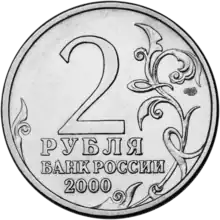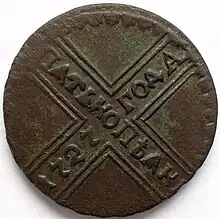решка
Russian

Решка 2 рублей выпуска 2000 г.
Etymology
From решётка (rešótka, “tails (since 1730s, now obsolete); lattice, grid”), from решето́ (rešetó, “sieve”), likely referring to the design of 5 kopeck copper coins in the 1720s (Fig. 2), or perhaps to the earlier silver kopeck coins.

Possibly the earliest sieve-like design of решка
Pronunciation
- IPA(key): [ˈrʲeʂkə]
Noun
ре́шка • (réška) f inan (genitive ре́шки, nominative plural ре́шки, genitive plural ре́шек)
- (dialectal) sieve
- Просей зерно через решку.
- (colloquial) tails (the side of a coin not bearing a coat of arms)
Usage notes
- The terms орёл (orjól) and ре́шка (réška) are applicable only to coins which, like Russia's coinage, have a coat of arms on one side and something else (e.g. the portrait of the head of state or the value of the coin) on the other. The terms аве́рс (avérs) and ре́верс (révers) are more universally applicable, but used mainly in numismatics.
Declension
This article is issued from Wiktionary. The text is licensed under Creative Commons - Attribution - Sharealike. Additional terms may apply for the media files.